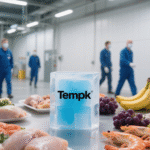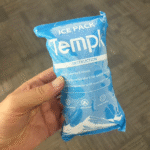Paquet de 100 Packs de glace sec: How to Ship Smarter in 2025
If you’re scaling frozen or ultra-cold shipping, un paquet de 100 packs de glace sec helps you standardize pack-outs, control costs, and keep lanes stable across seasons. Mis à jour Octobre 2025, this guide shows you how to size your program, rester conforme, and cut loss rates without sacrificing speed.
-
Sizing rules that turn transit hours into the dry-ice mass you actually need
-
Safety and labeling steps that pass 2025 airline acceptance checks
-
When VIP insulation and PCMs beat dry ice on total cost for your lanes
-
Ways to roll out training and QA that scale with order volume
-
Inventory rhythms and reorder points for a paquet de 100 packs de glace sec achat
Why buy a pack of 100 packs de glace sec?
-
Cohérence: Standardizes dosing across shifts and sites.
-
Vitesse: Pre-bagged portions cut pack-out time per order.
-
Qualité: Uniform refrigerant mass reduces variation.
-
Évolutivité: Easier to plan weekly rhythms.
Quand est-ce qu'un paquet de 100 dry ice packs make sense?
Choose a pack of 100 dry ice packs when you ship frozen goods daily and need repeatable, fast pack-outs at sub-zero set points.
You gain predictability because every portion is identical, helping new staff follow SOPs and reducing re-packs. High-quality packs hold sub-zero temperatures for about 24–72 hours depending on insulation quality. Reusable packs survive up to 30 cycles with careful handling, saving budget while raising service levels.
Blocs, boulettes, or pre-bagged portions?
| Format | Mieux pour | Workflow fit | Ce que cela signifie pour vous |
|---|---|---|---|
| Blocs/dalles | Long duration lanes | Moins de pièces | Sublimation plus lente |
| Granulés/Nuggets | Fast pull-down | Flexible dosing | Sublimation plus rapide |
| Pre-bagged portions | Repeatable pack-outs | Time-saving | Consistent QA |
Material options
| Type de paquet | Durée de refroidissement | Poids | Meilleur cas d'utilisation |
|---|---|---|---|
| HDPE shell pack | 48–72 h | Lumière | Long-distance pharma |
| Gel-based PCM pack | 24–48 h | Modéré | Kits de repas |
| Bio-based reusable pack | 36–60 h | Moyen | Sustainable operations |
Conseils pratiques
-
Multi-day transit: Blend ~80% blocks + ~20% pellets.
-
Des emballages plus propres: Bag pellets to reduce CO₂ “snow.”
-
Réutilisation: Track cycles and retire damaged packs.
Étude de cas: A dessert brand cut returns by half after switching to pre-bagged portions. Pack time fell by 30 seconds per order.
Quelle quantité de neige carbonique devriez-vous utiliser?
Planifier 5 à 10 lb de glace sèche par 24 h of transit inside an insulated shipper; add one day for delays.
Pour 40 frozen orders/day and two-day lanes, il te faut environ 560 lb daily. Un paquet de 100 × 5-lb portions covers 500 kg, so order two weekly to maintain inventory.
Estimateur rapide
Safe and compliant packaging
Vent every container, label UN 1845, and train staff on PPE and CO₂ safety.
Dry ice releases gas that displaces oxygen—vent lids, post signage, and monitor storage rooms.
| Focus de la sécurité | Ce qu'il faut faire | Pourquoi ça compte |
|---|---|---|
| Ventilation | Use vented lids | Prevents oxygen loss |
| Étiquetage | Mark UN 1845 + poids | Meets IATA rules |
| Surveillance | Use CO₂ sensors | Ensures safe workspace |
When to switch to PCMs or gels
Use PCMs for tight 2–8 °C control or reusable loops, and reserve dry ice for < −20 °C or fast pull-down.
PCMs simplify paperwork; gel packs suit short local routes. Beaucoup 2025 shippers blend −21 °C PCM with dry ice to balance cost and safety.
2025 trends in ultra-cold shipping
Reusable packaging and smarter insulation dominate 2025. Programs adopting VIP shippers cut refrigerant mass by about one-third, while IoT monitoring reduces excursions.
Derniers développements
-
VIP + Hybrides PCM: Small dry-ice loads ease DG paperwork.
-
Dimensionnement correct: Validated kits reduce ice use 15–30%.
-
Surveillance du CO₂: Low-cost sensors now standard.
Questions fréquemment posées
Puis-je voler avec de la neige carbonique?
Oui : utilisez un emballage ventilé, mark UN 1845 et poids net, et suivez les règles IATA.
How should I store it?
Keep in a cool, ventilated room with loose lids. Never in a sealed freezer.
How long will it last?
Expect 5–10 lb to sublimate every 24 h; premium insulation lowers the rate.
Will it damage packaging?
Extreme cold can make thin plastics brittle—add a liner and avoid direct contact.
Is “dry ice pack” the same as gel pack?
Non. La glace carbonique est du CO₂ solide (−78,5 ° C); gels use water-based PCMs for higher temps.
Idées de liens internes (for your own site)
-
Validated −80 °C shippers for biologics
-
PCM 2–8 °C pack-out guide
-
Dry-ice safety checklist
-
Frozen pack-out SOP template
Summary and advice
Choisissez un paquet de 100 packs de glace sec to standardize frozen shipping, follow the 5–10 lb/24 h rule, and design vented, labeled packaging. Use VIPs or −21 °C PCMs when they reduce cost, and train teams for safe, repeatable pack-outs.
Prochaine étape: map your top three lanes, run an A/B test, and finalize your SOP this week.
À propos du tempk
We engineer and validate cold-chain packaging for food, Soins de santé, et matériaux avancés. Our tested kits around a paquet de 100 packs de glace sec typically reduce dry-ice use by 15–30% while maintaining lane time.
Action: Get a quick consultation to validate your configuration.
























